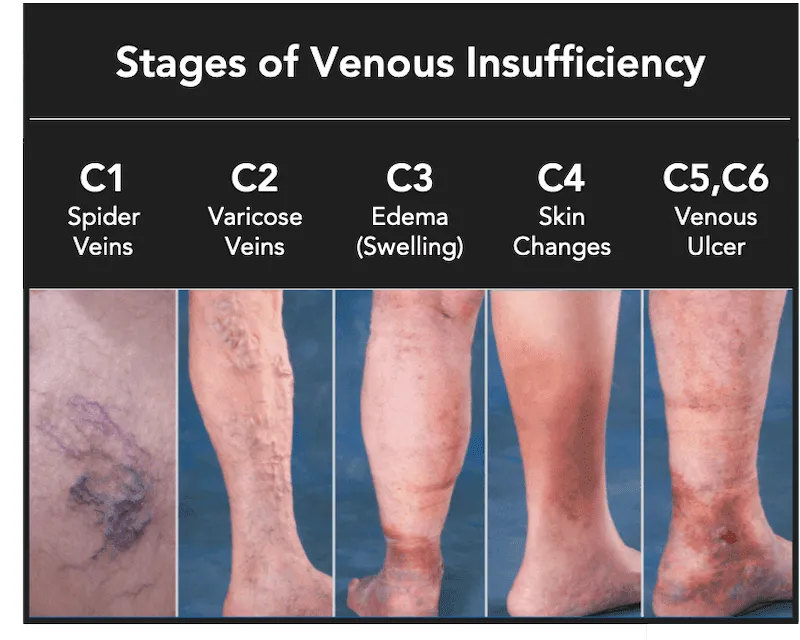What Is CVI?
Chronic Venous Insufficiency (CVI) is a medical condition affecting the veins in the legs, hindering the normal flow of blood back to the heart (NGO).

What is Chronic Venous Insufficiency?
At its core, CVI is characterized by the veins’ inability to efficiently transport blood from the legs to the heart. This inefficiency is often due to damaged or malfunctioning vein valves, which prevent blood from flowing backward. As a result, blood pools in the legs, leading to various symptoms and complications. CVI can stem from a range of causes, including deep vein thrombosis (DVT), valvular incompetence, and prolonged standing or sitting that exacerbates the condition (NIH).
Prevalence of CVI
CVI is a common condition that affects a significant portion of the adult population, with an annual incidence of 2.6% in women and 1.9% in men. Research shows that women are three times more likely to develop CVI than men. Additionally, the risk of developing CVI increases with age, making it a growing concern among the elderly population. It is important to proactively manage the condition to mitigate its impact on your quality of life (NIH).
Significance of CVI
The implications of being diagnosed with Chronic Venous Insufficiency extend beyond the physical symptoms it induces. It significantly affects individuals’ quality of life, potentially causing debilitating pain, skin changes, and even ulcers that are challenging to heal. CVI can increase the risk of developing more severe conditions such as deep vein thrombosis (DVT), which puts patients at a higher risk of heart attacks, strokes, and pulmonary embolism due to compromised blood flow.
The Physiology of Chronic Venous Insufficiency
Understanding the physiological underpinnings of Chronic Venous Insufficiency (CVI) is essential for comprehending its development and progression. CVI is rooted in the dysfunction of the venous system in the legs, involving the peripheral veins, which include the deep, superficial, and perforating veins. These veins play pivotal roles in circulating blood back to the heart, especially when working against gravity.
Components of the Venous System
- Deep Veins: These are the large veins that run through the muscles of the legs, playing a primary role in returning blood to the heart.
- Superficial Veins: Positioned closer to the skin, these veins collect blood from the skin and tissues immediately beneath it.
- Perforating Veins: Acting as connectors, these veins allow blood to flow between the deep and superficial veins (Cleveland Clinic).
Development of CVI
CVI can develop due to various factors affecting these venous components:
- Valvular Incompetence: This is often the primary cause, where the valves in the veins, designed to prevent backflow of blood, do not function properly. This dysfunction can lead to blood pooling in the legs.
- Venous Blockage: Both thrombotic (clot-related) and non-thrombotic blockages can impede blood flow, contributing to CVI.
- Extrinsic Blockage: External pressures on the veins can also hinder venous blood flow.
Age plays a significant role in the development of CVI. As individuals age, the efficiency of the venous valves may diminish, compounded by factors like limited mobility and the normal loss of muscle mass. Additionally, prolonged standing can exacerbate the risk by increasing the pressure in the leg veins, leading to venous hypertension when combined with faulty valves.
Skin Changes and Complications
The physiological changes associated with CVI can lead to noticeable skin changes and serious health complications:
- Hemosiderin Staining: This discoloration occurs when hemoglobin leaks from the vessels, leading to a red or brown stain on the skin.
- Venous Eczema: Characterized by dry, itchy, and sometimes flaky skin, this condition results from chronic inflammation.
- Lipodermatosclerosis: This condition involves the hardening of the skin, often resembling the shape of an upside-down champagne bottle, due to chronic inflammation and scarring.
- Atrophie Blanche: Identified by smooth, white scar tissue surrounded by hyperpigmented skin, indicating advanced stages of skin change.
In addition to skin changes, CVI can lead to more severe complications such as cellulitis, poor healing wounds, skin ulcers, and an increased risk of deep vein thrombosis (DVT). The latter poses significant risks, including heart attacks, strokes, and pulmonary embolism, due to the potential for blood clots to travel to critical organs.

YOU’RE NOT ALONE
Hundreds of thousands of patients are diagnosed with Chronic Venous Insufficiency each year. Here you’ll be able to learn about your condition, resources for managing your condition, and information you’ll be able to share with your friends and family!

I’m so glad I found this website! I was recently diagnosed with Chronic Venous Insufficiency, and it felt really scary. Talking to my doctor helped, but I was really interested in having a resource to help me better understand the condition on my own time, and something I could share with my friends and family too! Thank you for putting this together!
![]()
VIOLET, FORT WORTH, TX
Meet Our Team
We’re just normal graduate students in the Masters of Physiology Program at North Carolina State University. We love learning about physiology, and are working towards careers where we’re able to help people improve their health through education!

Ken, Sarah, Osaru, Megha, Khira, Andre